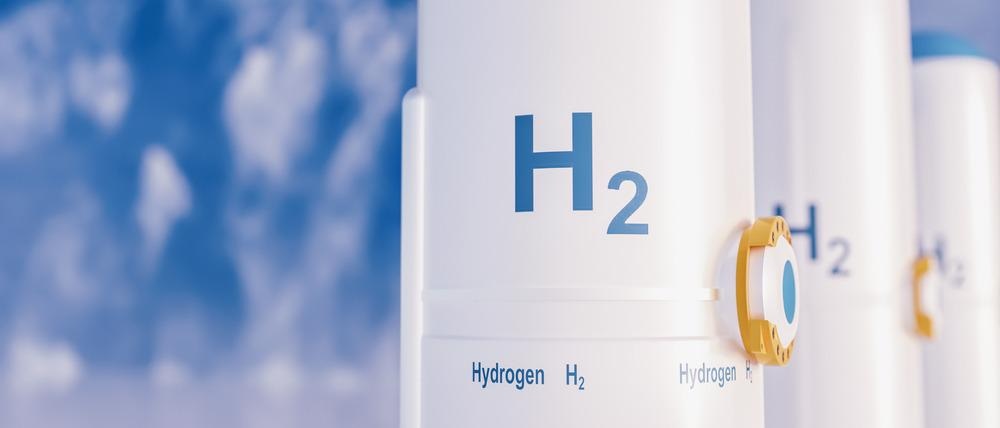AZoM talked to Ailong Li, a postdoctoral researcher at RIKEN, about his research that has developed a green catalyst for the production of hydrogen energy. This could revolutionize efforts to leave fossil fuels behind in the production of clean energy.
Please can you introduce yourself and how you began researching hydrogen production?
My name is Ailong Li, a postdoctoral researcher at RIKEN. I grew up in China and have been working in Japan for about 5 years. I first started working on artificial photosynthesis using titanium oxide (TiO2) as a sunlight absorber. To me, it sounded remarkable to mimic photosynthesis in plants by converting water into protons and oxygen and converting carbon dioxide into fuel using only sunlight.
However, the lack of efficiency of TiO2, which only absorbs UV light from the environment, prompted me to consider a more efficient way to convert fluctuating renewable energy sources into artificial fuel. I then chose electrolysis to produce renewable hydrogen from renewable electricity derived from not only solar but also hydro, wind, hydrothermal, etc. power. With renewable hydrogen, we can do a lot of sustainable chemical synthesis and conversion, such as ammonia and hydrocarbons.
With the climate crisis driving research innovations, how important is it to establish clean energy alternatives?
We should make it a top priority. We have relied on fossil fuels for centuries and will do so for decades to come. However, we cannot rely on it forever because it is not renewable. Any clean and sustainable technology that reduces emissions and waste is welcome. Green hydrogen production from renewable energy sources is one of the most important technologies for a sustainable future.
Could you briefly outline the water electrolysis process that produces hydrogen?
Water electrolysis is the most developed and mature technology to extract hydrogen from water. Electricity is used as the energy source in water electrolysis. In order to increase the efficiency from electricity to hydrogen, catalysts are used in this process. We usually refer to the catalysts in water electrolysis as electrocatalysts.
Hydrogen production still frequently relies on the use of fossil fuels. Why is this, and how is this hindering movements toward becoming net-zero?
Worldwide, renewable hydrogen is still more expensive than hydrogen from fossil fuels. The situation is changing for the better, as many countries, especially in Northern Europe, have abundant renewable electricity. In this case, green hydrogen is becoming cheaper than fossil fuels. This could facilitate the penetration of green hydrogen into more industrial sectors. The development of renewable electricity should be a top priority, along with the development of more efficient electrolysis technologies.

Image Credit: Audio und werbung/Shutterstock.com
Why has the greener use of catalysts for water electrolysis been limited?
A TW-scale polymer electrolyte membrane (PEM) electrolyzer would require 520 tons of iridium, equivalent to 50-60 years of iridium production, not including competing uses by other industries. However, Iridium is the rarest element in the earth's crust. Its production is only about 7 tons per year and its supply is inflexible because it is a by-product of platinum. Therefore, it is necessary to develop technologies for iridium recycling, reduce the amount of iridium used, as well as develop non-precious catalysts.
Which materials did you use in your research to circumvent previous limitations in catalysts?
We first used γ-MnO2 in our research. In 2019, we identified a stable potential window for γ-MnO2 in which the OER can be catalyzed efficiently while simultaneously suppressing deactivation pathways. At the time, non-precious metal catalysts in the literature had difficulty maintaining activity for more than a week at a current density of 10 mA cm-2, while manganese oxide was able to stably electrolyze water for several months within its stable potential window.
To further increase its power density and to reduce the footprint, we need a more active material. In a recent report, we prepared a new catalyst (Co2MnO4) by mixing cobalt, which has excellent activity, with manganese, which has excellent stability, through a thermal decomposition method. The obtained material shows both high activity and stability, as the catalyst was able to electrolyze water continuously for 1500 hours at 200 mA cm2. Compared to γ-MnO2, it can operate stably at current densities 20 times higher.
How well does the catalyst in your latest study perform compared to previous models?
This is the first earth-abundant catalyst that reaches 2 A cm-2 at a voltage of 2 V. Our electrode has a lower overpotential compared to previous earth-abundant electrodes, regardless of its activity being normalized vs the geometric area, the electrochemical surface area, or the loading amount of the catalyst.
For an electrocatalyst, the lower overpotential achieved implies a higher electricity to hydrogen conversion efficiency. The total amount of hydrogen produced during its active time is also about one order of magnitude higher compared to the previous ones.
What are the implications of using non-rare-earth metals in regard to the commercial upscaling of hydrogen production?
Non-rare-earth metals are more desirable for scaling up and reducing the cost of renewable hydrogen. Their abundance of supply is another benefit, as in the Earth’s crust manganese is 106 times more abundant than iridium. The price of iridium increased by 6-times during the last 5 years, reaching 4,000.00 USD/ozt now. The use of non-rare-earth metals will undoubtedly reduce its reliance on precious metal supply and scaling-up of the PEM electrolysis technology, and be helpful to reduce the price of green hydrogen.
What applications will this green hydrogen be crucial for?
The green hydrogen produced from water electrolysis is the bridge to connect renewable electricity to the chemical society. Assume we have abundant renewable electricity from solar, wind, and hydrothermal energy. We need to be ready to move to the second stage, converting the abundant renewable electricity into chemicals, fertilizers, pharmaceuticals, and fuels, and to replace industrial processes that consume abundant fossil fuels and produce huge emissions. For example, green hydrogen can be used for ammonia synthesis, which accounts for about 2% of the world's fossil fuel primary energy consumption.
Are there any limitations you are yet to overcome? If so, how will you tackle them?
Compared to iridium, manganese and cobalt-manganese-based spinel oxides are still less active and less stable. We are now focusing on their main structural parameters in order to optimize these materials. Manganese itself has a wide structural space, and we can also change its composition with other different elements.
For example, in nature, there are about 1800 different types of minerals that contain manganese. We have a huge scope to further promote their properties, especially their stability, with manganese, cobalt, and other non-rare-earth metals.
What must be done to produce a clean and cost-effective hydrogen economy on a global scale?
We must have an abundant supply of renewable electricity. We need to build more and more power plants with solar, wind, geothermal, etc. Anything that can facilitate this will help. Then the cost-effective hydrogen could be produced with advanced water electrolyzers, as we are developing now. At the same time, renewable hydrogen from biomass and other renewable resources can also contribute to the cost-effective hydrogen economy.
Was there any part of this research that was especially surprising or interesting to you?
I was so excited to see the intensive bubble generated from the surface of the catalyst every time I did the experiments. It not only suggests the high activity of our catalyst, but is also beautiful to watch.

Image Credit: Makoto Oikawa
What are the next steps? Will you proceed in researching catalysts for hydrogen production?
I will continue developing efficient catalysts. The catalyst is usually one of the most important parts of a chemical reaction. It creates a reaction pathway with lower activation energy which is not possible in its absence. It saves energy and ensures natural resources can be used more efficiently.
Where can readers find more information?
Considerations for the scaling-up of water-splitting catalysts. https://www.nature.com/articles/s41560-019-0407-1
The stable potential window for over 8000 hours stability in acid. https://onlinelibrary.wiley.com/doi/10.1002/anie.201813361
Potential to stabilize. https://www.nature.com/articles/s41560-019-0379-1
Enhancing the stability of cobalt spinel oxide towards sustainable oxygen evolution in acid. https://www.nature.com/articles/s41929-021-00732-9
A new, sustainable way to make hydrogen for fuel cells and fertilizers. https://www.riken.jp/en/news_pubs/research_news/pr/2022/20220215_1/index.htm
About Ailong Li
 Ailong is a postdoctoral researcher in RIKEN, and he has just started his career in electrolytic technologies and materials. He is confident that his recent work is a contribution towards a carbon-neutral society. Ailong hopes the same can be said for his next 30-40 years as a researcher.
Ailong is a postdoctoral researcher in RIKEN, and he has just started his career in electrolytic technologies and materials. He is confident that his recent work is a contribution towards a carbon-neutral society. Ailong hopes the same can be said for his next 30-40 years as a researcher.
Disclaimer: The views expressed here are those of the interviewee and do not necessarily represent the views of AZoM.com Limited (T/A) AZoNetwork, the owner and operator of this website. This disclaimer forms part of the Terms and Conditions of use of this website.